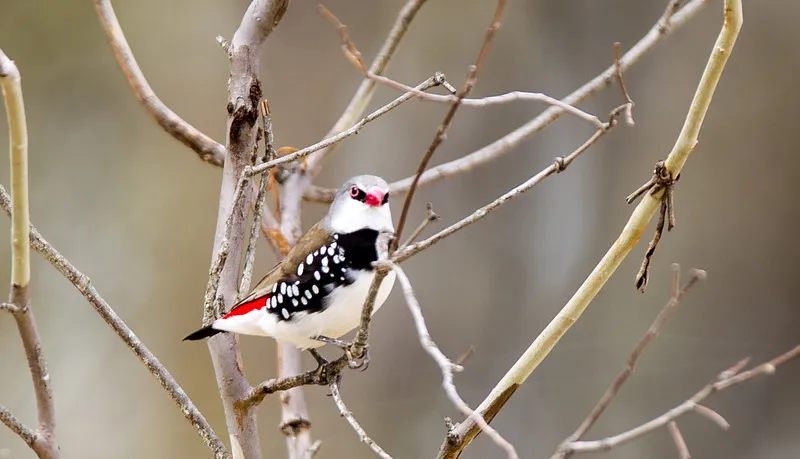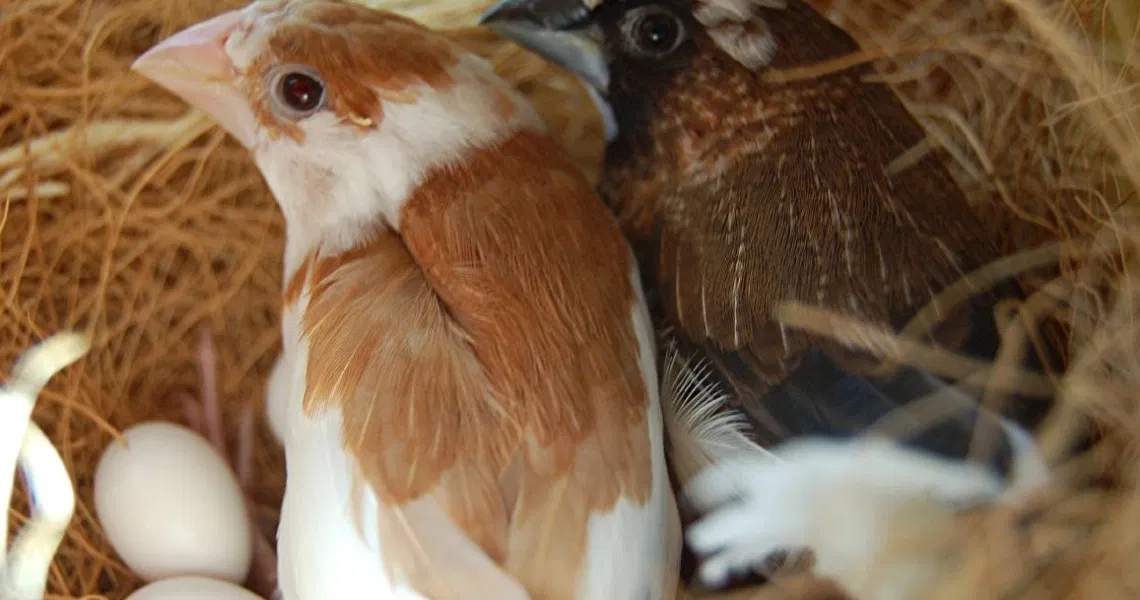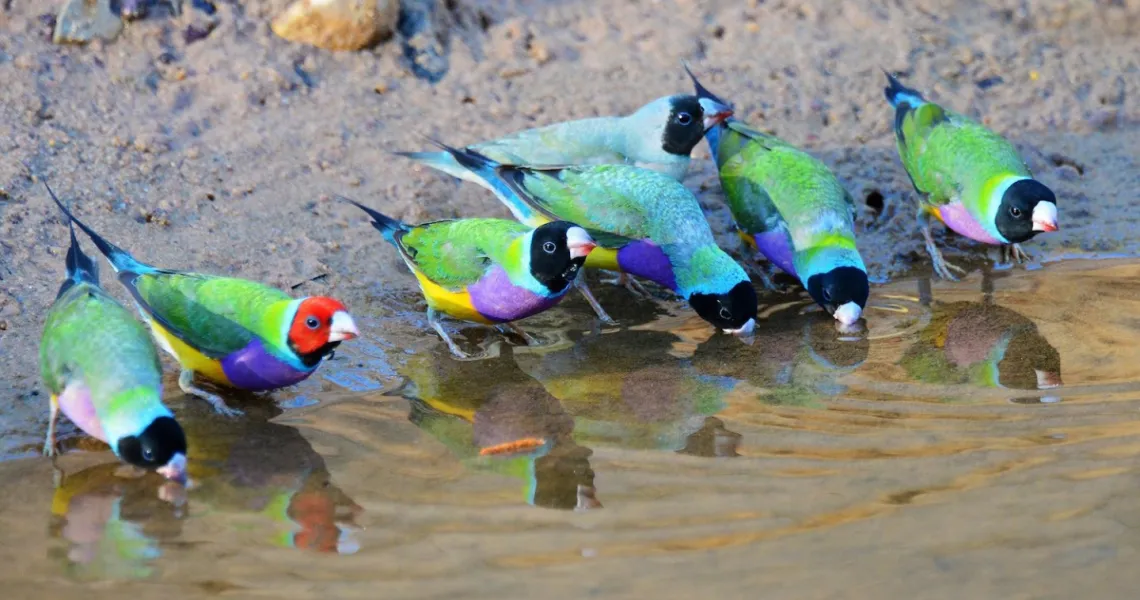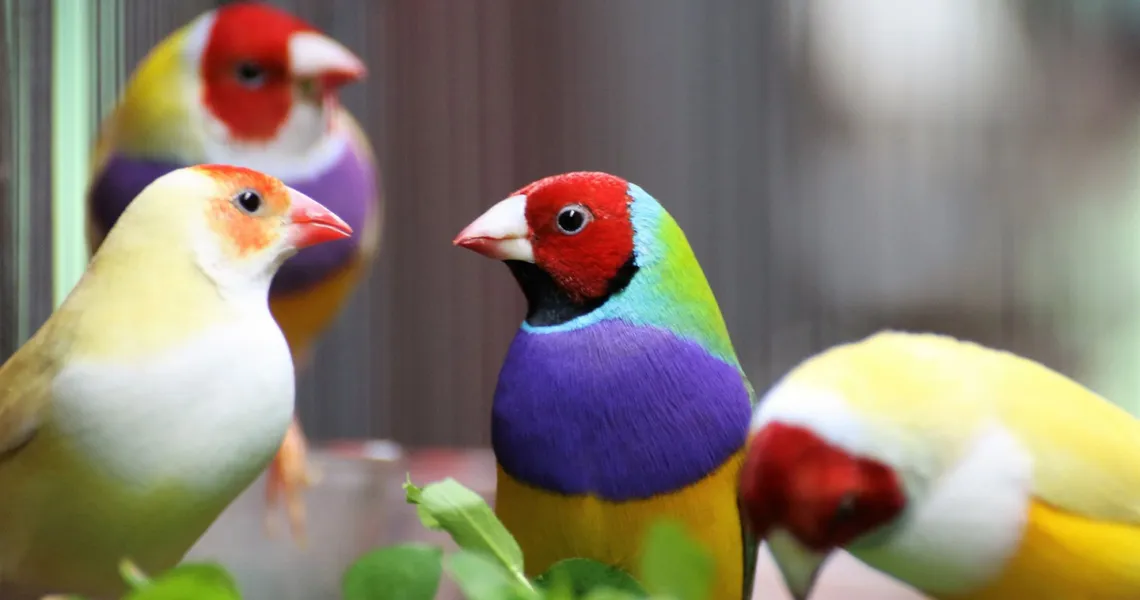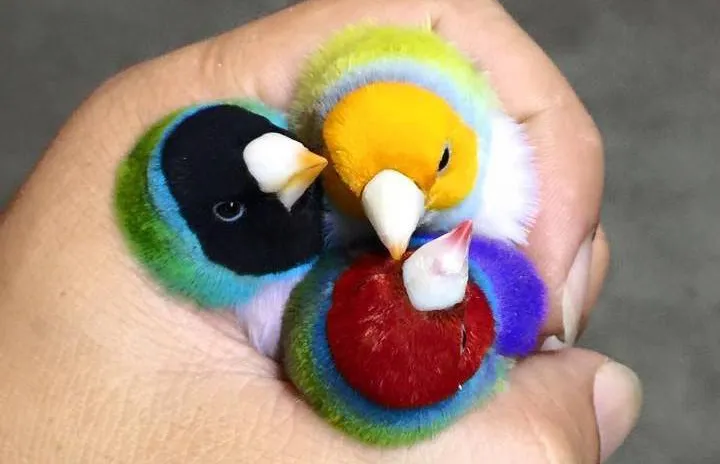
Gouldian Finch Color Mutations
By longnkp / Jul 07 2024 / General
In the world of Gouldian finches, the vibrant array of colors and intricate genetic combinations create a fascinating tapestry that captivates bird enthusiasts and breeders alike. Understanding how these colors are inherited, their interactions with each other, and their impact on the bird's appearance is key to appreciating the beauty and complexity of Gouldian finch breeding.
A. HEAD COLOR
1 - Red Head (RH)
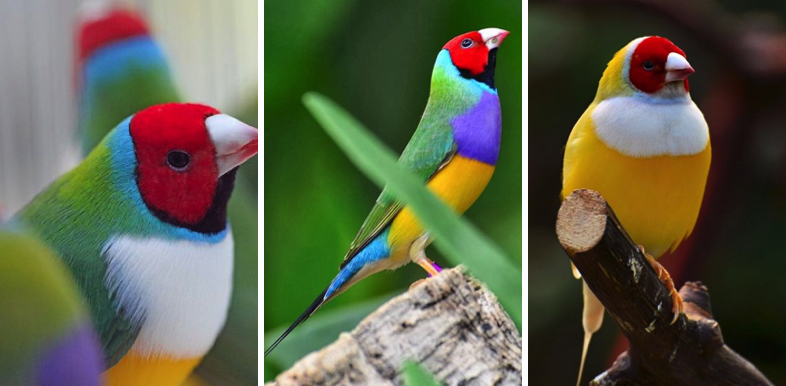
Red Head Gouldian Finch
The gene that determines the red head trait is completely dominant and located on the sex chromosomes (sex-link dominant). Birds with ZZ chromosomes are male, and those with ZW chromosomes are female. Therefore, male Gouldian finches can carry two genes for the red head trait (ZZ - homozygous) or one gene for red and one for black (Zz - heterozygous) and still exhibit the red head phenotype. As a result, it is very challenging to determine whether our red-headed male or female finches are purebred without using breeding tests for accurate identification.
2 - Black Head (BH)
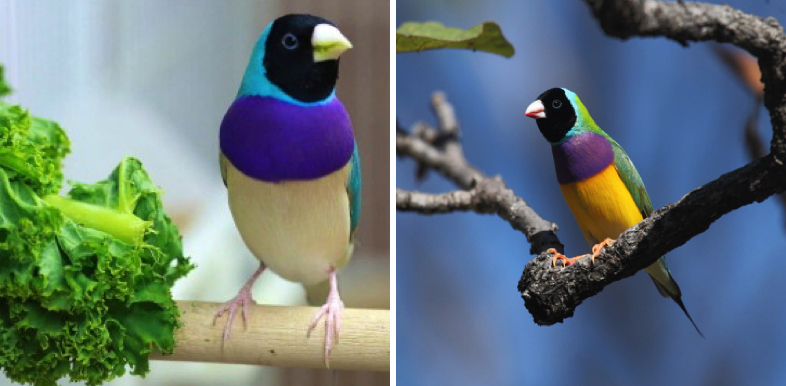
Black Head Gouldian Finch
Similar to the gene that determines the red head trait, the gene that determines the black head trait is also located on the sex chromosomes (sex-link), but it is a recessive gene. For a male bird to have a black head, it must carry two genes for this trait (zz - homozygous). Female birds, however, only need one gene for the black head trait (zW) to express the black head phenotype.
3 - Yellow Head (YH)
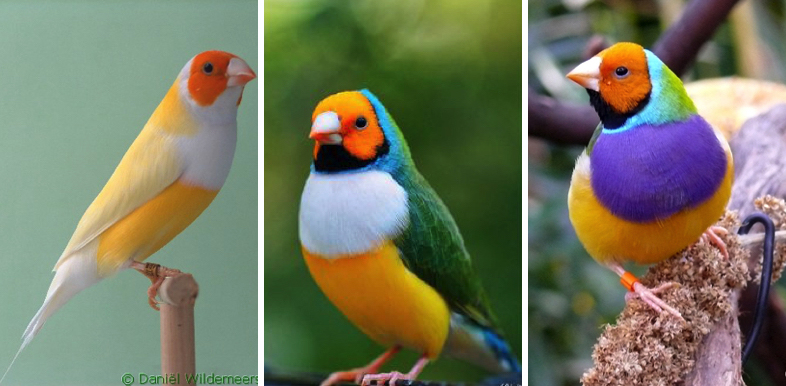
Yellow Head Gouldian Finch
Unlike the genes that determine red and black head colors, which are sex-linked, the gene for the yellow head color is a normal autosomal recessive gene. This explains why wild Gouldian finches with yellow heads are very rare. Interestingly, the expression of the yellow head trait depends on the presence of at least one red head gene. This means that if a bird, whether homozygous or heterozygous for the red head trait, has two yellow head genes, it will display a yellow head. However, if a black-headed bird carries two yellow head genes, it will still exhibit a black head, with the yellow head trait remaining "in name only." Black-headed birds with two yellow genes will have yellow tips on their beaks, distinguishing them from typical black-headed birds. Both red and black-headed males and females can carry one yellow gene without showing the yellow head phenotype, so breeding tests are necessary for accurate identification.
B. BREAST COLOR
Gouldian finches have three basic breast colors: purple, lilac, and white. The purple color is the natural and most common color seen in birds for sale. The white color, although bred selectively, is also quite common. The lilac color is less frequently seen. Note that the lilac color is a light, attractive purple, and should not be confused with the "faulty white" Gouldian finches that have a dirty white breast with a tinge of purple. Another new color that has appeared is blue, but it is not yet stable or common.
1 - Purple Breasted (PB)
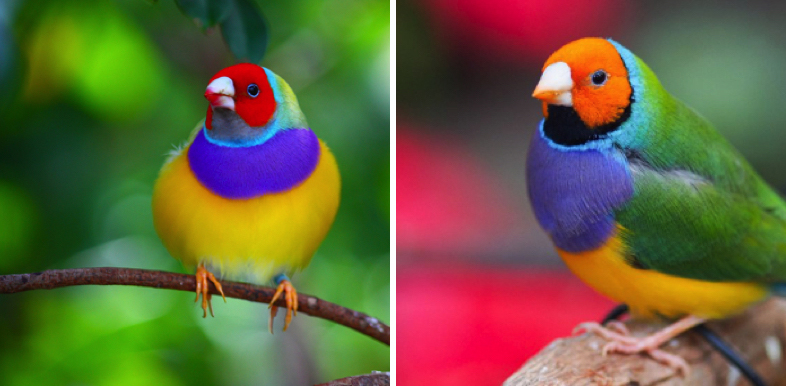
Purple Breasted Gouldian Finch
As the most common color, the gene for the purple breast is completely dominant. Therefore, both male and female Gouldian finches can have purple breasts but may still carry the recessive genes for lilac or white breasts.
2 - Lilac Breasted (LB)
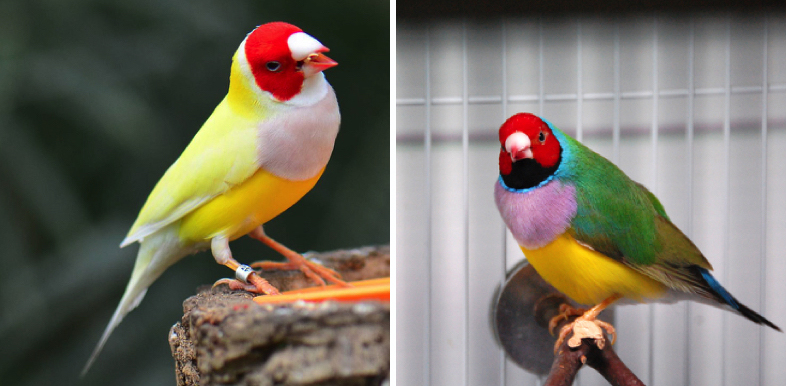
Lilac Breasted Gouldian Finch
This color, if observed closely, is also very beautiful and interesting. The gene for the lilac breast is incompletely dominant. If paired with the purple gene, the bird will have a purple breast, but if paired with the white gene, it will result in a lilac breast.
3 - White Breasted (WB)
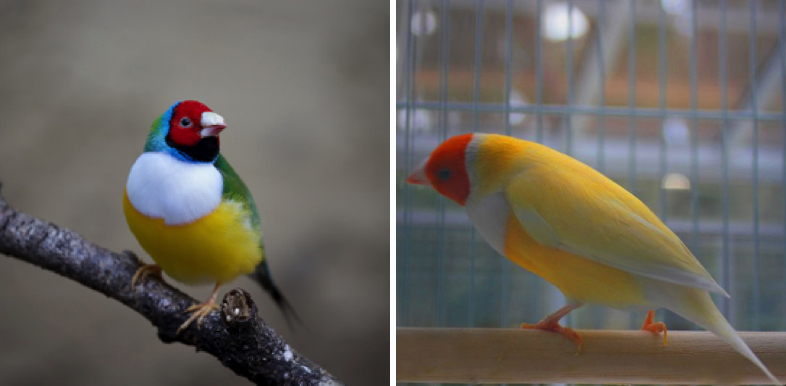
White Breasted Gouldian Finch
This is a selectively bred color, with the gene for the white breast being completely recessive compared to the purple and lilac genes. Therefore, two white breast genes are required to produce a bird with a white breast. To achieve the desired offspring, you can pair white-breasted birds or birds that carry the white breast gene (split for white breast) with each other.
C. BACK COLOR
The back color is the most noticeable to bird enthusiasts, as this area covers the majority of the bird's body. Besides the very new, selectively bred colors that are not yet numerous or stable enough to be recognized as distinct breeds, we will focus on the well-known colors here.
Female Gouldian finches have four back colors: green, yellow, blue, and silver. Male Gouldian finches, on the other hand, have six back colors: green, dilute green (also known as dilute), yellow, blue, pastel blue, and silver.
1. Green Backed (GB)
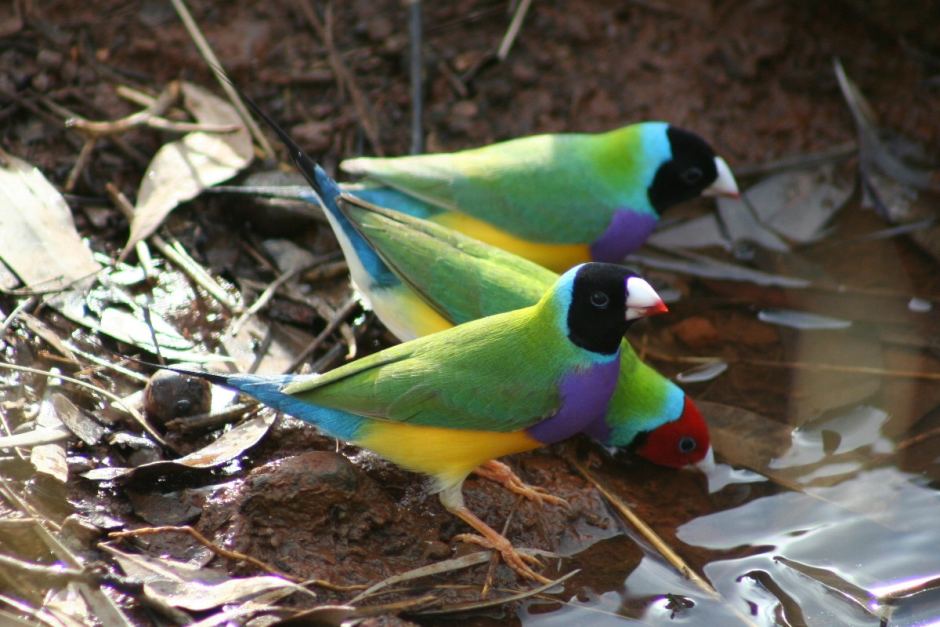
Green Backed Gouldian Finch
After years of breeding, it seems that the domesticated green-backed Gouldians have changed slightly from their wild counterparts, with more vibrant colors.
The green color is the most common and natural color of Gouldians. Like the gene for the red head, the gene for the green back is dominant and located on the sex chromosome (sex-link). The green gene is also dominant over the blue back gene. A male green-backed bird can either be homozygous (ZZ - pure) or heterozygous (Zz - not pure), while a female only needs one green gene (ZW - pure). The green back can be combined with all head and breast colors. However, if a male has one green gene and one yellow gene and also has a purple breast, it will appear as a dilute green (explained further below). If the same male bird has one green gene and one yellow gene but has a lilac or white breast, it will have a yellow back. This phenomenon occurs because the green back is not solely determined by the sex-linked gene, it also depends on the breast color gene and the blue back gene.
2. Yellow Backed (YB)
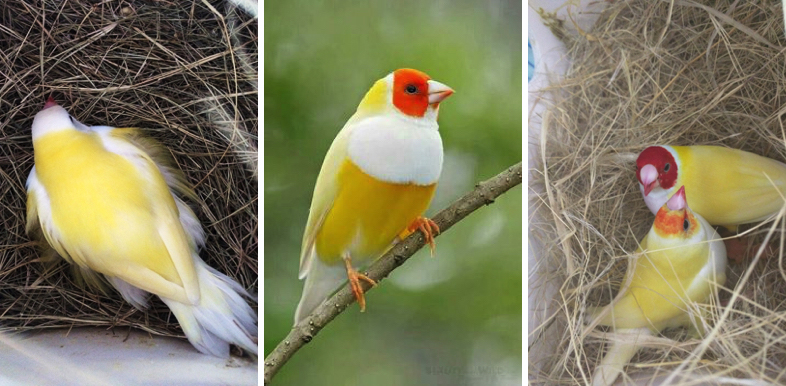
Yellow Backed Gouldian Finch
Similar to the gene that determines the black head color, the gene for the yellow back color is incompletely dominant and located on the sex chromosome. Therefore, a male bird needs two yellow genes (zz - pure) to exhibit a yellow back, while a female bird only needs one (zW - pure). As mentioned earlier, a male bird with only one yellow gene will have a yellow back if it has a lilac or white breast; otherwise, it will have a dilute green back. The yellow gene suppresses the expression of black color, so areas that would be black on a wild bird will appear as grayish-white on a yellow-backed bird, and a black-headed bird with a yellow back will have a head that is nearly white.
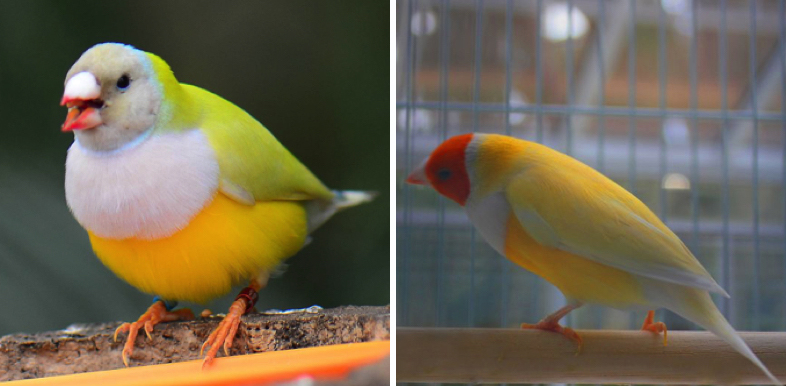
In this photo, male finch with yellow head, white breast, and yellow back. This bird carries only one yellow gene (single factor). Note the yellow-green coloration on the back of the bird, with a blue hue still present around the head
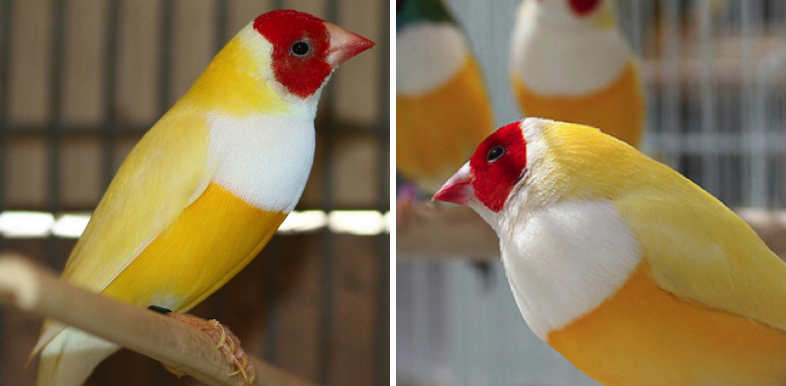
As explained above, this is a double-factor yellow finch. Note that the blue hue around the head is almost white.
3. Dilute
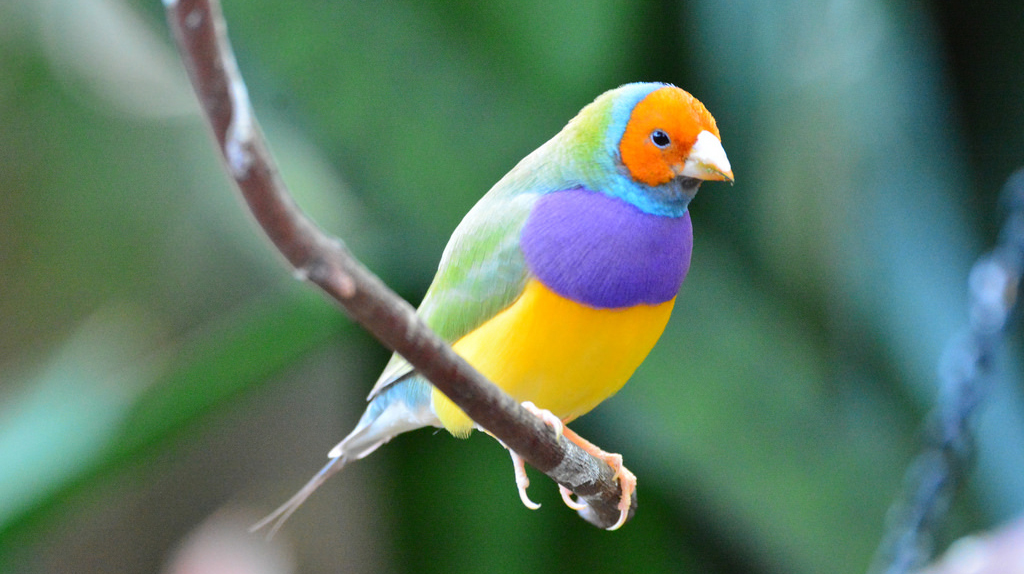
Dilute Gouldian Finch.
This is a special phenomenon as discussed earlier. When a bird carries one yellow gene and one green gene, because the yellow gene is incompletely dominant, the bird cannot show fully yellow or fully green coloration. Instead, it displays a blend of yellow and green hues. Dilute green birds exhibit traits of yellow-backed birds: areas that would be black on the body are replaced with grayish-white. Since dilute green birds require both yellow and green genes, and these genes are located on the sex chromosome, all birds with this coloration are males (Zz).
There have been some female birds with dilute green back coloration, but this is a rare mutation known as Cinnamon, completely different from the type we discussed earlier.
4. Blue
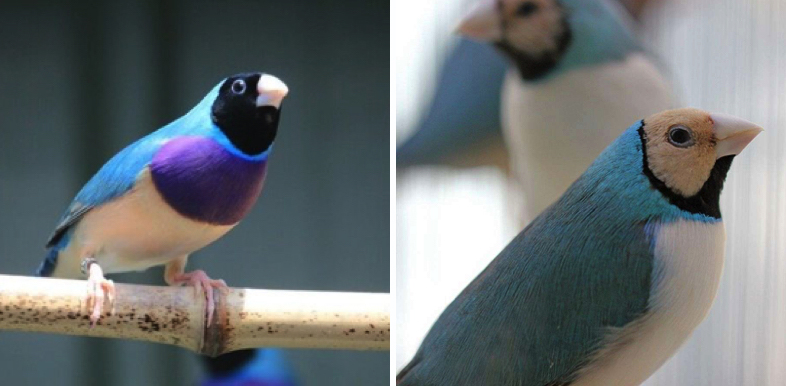
Blue Gouldian Finch.
The gene for the blue back color in Gouldian finches is recessive and operates similarly to the yellow head gene. The blue back color requires the presence of the green back gene to manifest outwardly. Therefore, if a green-backed bird has two blue genes, it will appear as a blue-backed bird; if it carries only one blue gene, it will have a green back and is referred to as "Split to Blue". Gouldian finches that are Split to Blue (carrying only one blue gene) can be identified by careful observation, as the areas that would be blue on a wild bird are more extensive, broader, and more vibrant in color on these birds.
The blue back gene can combine with any head or breast color. However, due to the nature of restricting the appearance of yellow, areas that would be yellow or red on wild Gouldians turn into a cream color on birds with the blue back gene. Therefore, a blue-backed bird, whether with a red or yellow head, will have a "straw head" appearance.
5. Pastel
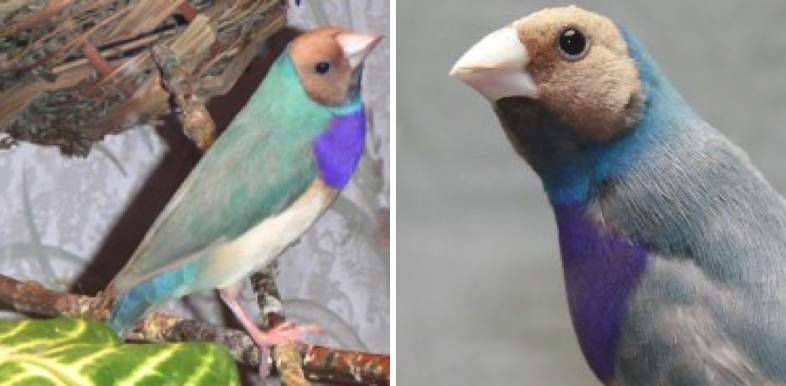
Pastel Gouldian Finch.
This phenomenon occurs when a bird has two blue back genes but only one green back gene (the other gene being yellow), and it has a purple breast. (If it had a white breast, the bird would become silver - this will be explained below). Like dilute blue birds, this phenomenon only occurs in male birds (carrying two genes for color on the sex chromosomes - Zz). Because the blue back gene limits the appearance of yellow/red coloration, and the yellow gene limits the appearance of black coloration, black-headed birds will turn into "gray heads"; birds with yellow or red heads will turn cream-colored, sometimes nearly white; and the back, which would normally be blue, will fade significantly.
6. Silver
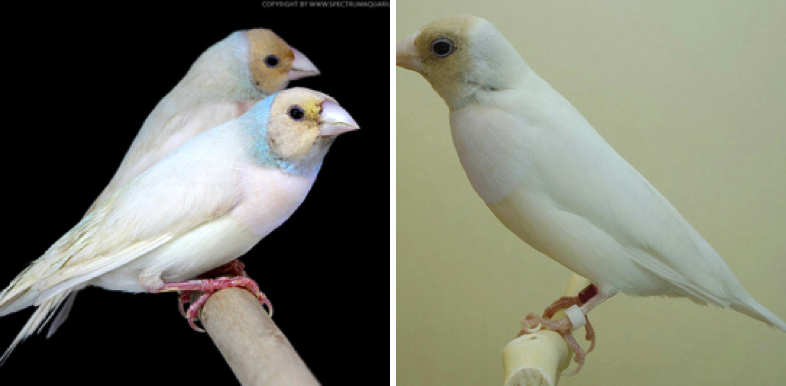
Silver Gouldian Finch.
The silver coloration occurs when a bird carries two yellow genes (on the sex chromosomes) and two blue back genes, or one yellow gene and two blue back genes with a white breast. This combination results in the yellow genes largely suppressing black/blue coloration, and the blue back genes mostly suppressing yellow/red coloration on the bird's body, leaving it almost entirely devoid of color (nearly white). Red or yellow heads will still appear as cream-colored, while black heads will appear as white. Breeders utilize this phenomenon to create birds that are nearly entirely white (black head, white breast, silver back).
Relative Posts
Recent Posts
- Unlocking the Secrets of Calcium for Healthy Captive Birds
- Hand Feeding Finches
- Why Parents Toss Chicks and How to Help
- Fostering Finches: Ensuring the Survival of Your Feathered Friends
- Sunshine and Finches: A Guide for Indoor Bird Keepers
- Air Sac Mites in Finches: Understanding, Preventing, and Treating
- Introducing New Foods to Your Finch
- Homemade Finch Food Recipes
- Choosing Breeding Gouldian Finch Pairs
- How to Choose a Nest Box for Your Finches

